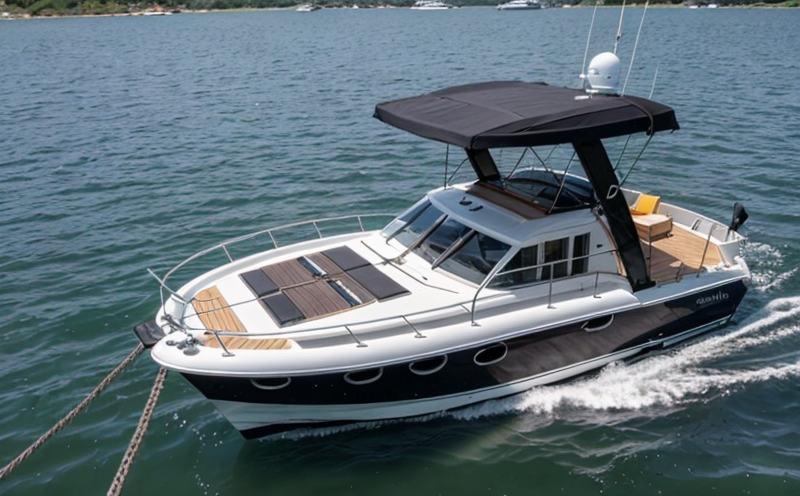ISO 9554 Fibre Rope Durability Testing under Marine Conditions
The International Organization for Standardization (ISO) specifies a range of tests that help ensure marine equipment meets stringent quality and safety standards. One such standard is ISO 9554 Fibre Rope Durability Testing under Marine Conditions. This service is critical for manufacturers, suppliers, and buyers of marine ropes who need to demonstrate compliance with global regulations and industry best practices.
Fibre ropes are an essential component in the maritime industry, used for mooring ships, anchoring vessels, securing cargo, and performing various deck tasks. The durability and reliability of these ropes under harsh marine conditions can significantly impact safety and operational efficiency. The ISO 9554 test provides a standardized method to assess the strength degradation of fibre ropes subjected to environmental stressors such as saltwater exposure, UV radiation, mechanical abrasion, and cyclic loading.
The testing process involves simulating real-world conditions that ropes encounter at sea. This includes immersion in seawater for extended periods, exposure to sunlight, and subjecting the specimen to repeated bending cycles. The primary goal is to evaluate the rope's resistance to degradation over time, ensuring it remains safe and functional under marine conditions.
Before testing begins, the fibre rope must be carefully prepared following prescribed procedures outlined in ISO 9554. This includes cutting the rope into specific lengths, conditioning it according to environmental factors, and attaching it to a suitable testing apparatus. The test setup typically involves a hydraulic or pneumatic loading device that applies cyclic loads mimicking real-world stresses.
The testing process itself is rigorous and lengthy, often taking several weeks depending on the required exposure time and load cycles. During this period, continuous monitoring ensures accurate data collection. Key parameters measured include elongation, tensile strength, and modulus of elasticity. If any parameter falls below acceptable limits, it indicates that the rope has degraded beyond safe use.
Once testing is complete, comprehensive reports are generated detailing test results. These reports serve as crucial documentation for compliance with international standards, aiding in decision-making processes regarding product approval, quality assurance, and risk management. For manufacturers, these tests provide valuable insights into potential improvements needed to enhance rope performance and durability.
The ISO 9554 test is not just a technical exercise; it represents a commitment to safety and reliability in the maritime sector. By adhering to this standard, companies can build trust with clients, regulators, and stakeholders, ensuring they meet or exceed global expectations for quality marine equipment.
Applied Standards
The ISO 9554 Fibre Rope Durability Testing under Marine Conditions is specifically aligned with the following international standards:
- ISO 9554:2018 – Specification for testing the durability of fibre ropes used in mooring, anchoring and deck equipment.
- ASTM D3866 – Standard test method for determining tensile properties of fiber rope.
- EN 14970-2:2015 – Specification for the performance of synthetic ropes used in mooring, anchoring and deck equipment.
- IEC 60328 – Tests on cables – Determination of tensile strength of cable samples intended for use as conductors in power cables.
These standards collectively provide a robust framework for ensuring the integrity and performance of fibre ropes used in marine applications. Compliance with these norms not only guarantees high-quality products but also facilitates easier market access and international trade.
Quality and Reliability Assurance
At our laboratory, we take pride in providing top-tier quality assurance services for all types of marine equipment testing. Our state-of-the-art facilities are equipped with advanced instrumentation capable of replicating the most challenging environmental conditions found at sea. This enables us to conduct thorough and accurate ISO 9554 tests that meet or exceed industry expectations.
Our team of highly skilled technicians adheres strictly to ISO 9554 guidelines, ensuring every step from specimen preparation to data analysis is meticulously documented. We employ rigorous quality control measures throughout the testing process to minimize errors and ensure consistent results. Our clients can trust us to deliver reliable outcomes that speak volumes about their products' durability and safety.
Moreover, we offer additional value-added services such as post-test analysis and certification issuance. These features allow our customers to leverage our expertise beyond mere compliance checks, gaining deeper insights into their product performance and identifying areas for improvement.
International Acceptance and Recognition
The ISO 9554 Fibre Rope Durability Testing under Marine Conditions is widely recognized and accepted across the globe. Its adoption by major maritime nations underscores its significance in ensuring safety and reliability of marine equipment:
- Norway – Leading in maritime innovation, Norway mandates compliance with ISO 9554 for all new fibre rope products entering the market.
- Brazil – As a key player in Latin American shipping, Brazil has incorporated this standard into its regulatory framework to enhance product quality.
- United States – The U.S. Coast Guard and major ports require compliance with ISO 9554 for all imported fibre ropes used in critical maritime operations.
- China – China, the world’s largest shipbuilding nation, has integrated this standard into its national standards to promote safety and efficiency in the industry.
- European Union – Many EU member states have adopted ISO 9554 as a key component of their maritime regulations.
The broad acceptance of this test demonstrates its importance in maintaining international trade standards. Compliance with ISO 9554 not only opens doors to these markets but also enhances brand reputation and consumer confidence.





